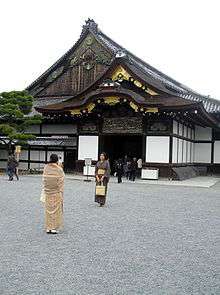Nightingale floor

 |
Daikaku-ji nightingale floor
The sound of a person walking on the "nightingale floor" of Daikaku-ji in Kyoto. |
| Problems playing this file? See media help. | |

Nightingale floors (鴬張り or 鶯張り uguisubari) ![]() listen , were floors designed to make a chirping sound when walked upon. These floors were used in the hallways of some temples and palaces, the most famous example being Nijo Castle, in Kyoto, Japan. Dry boards naturally creak under pressure, but these floors were designed so that the flooring nails rubbed against a jacket or clamp, causing chirping noises. The squeaking floors were used as a security device, assuring that none could sneak through the corridors undetected.[1]
listen , were floors designed to make a chirping sound when walked upon. These floors were used in the hallways of some temples and palaces, the most famous example being Nijo Castle, in Kyoto, Japan. Dry boards naturally creak under pressure, but these floors were designed so that the flooring nails rubbed against a jacket or clamp, causing chirping noises. The squeaking floors were used as a security device, assuring that none could sneak through the corridors undetected.[1]
The "nightingale" in the English name refers to the Japanese bush warbler, or uguisu. This is a type of bushtit or nightingale native to Japan.[2]
Construction
The floors were made from dried boards. Upside-down V-shaped joints move within the boards when pressure is applied.[3]
Etymology
Uguisu (鶯 or 鴬) refers to the Japanese bush-warbler. The latter segment bari (張り) comes from haru (張る), meaning "to stretch". Together this means "the sound of a Nightingale from the stretching/swelling/straining [of the floor]".
Examples
The following locations incorporate nightingale floors:
- Nijo Castle, Kyoto
- Chion-in, Kyoto
- Eikan-dō Zenrin-ji, Kyoto
- Daikaku-ji, Kyoto
Modern influences and related topics
- Melody Road in Hokkaido, Wakayama, and Gunma
- Singing Road in Anyanag, Gyeonggi South Korea
- Civic Musical Road in Lancaster, California
Notes
References
- A-Z Animals. "Uguisi" under "Animals". (2008). accessed November 3, 2012. http://a-z-animals.com/animals/uguisu/.
- Bunt, Jonathan and Gillian Hall, ed. Oxford Beginner's Japanese Dictionary. New York: Oxford University Press, 2000.
- Henshall, Kenneth G. A Guide to Remembering Japanese Characters. Vermont: Tuttle Publishing Company, 1998.
- Japan-guide.com. "Nijo Castle (Nihojo)" under "Kyoto Travel: Nijo Castle" (June 11, 2012). accessed November 3, 2012. http://www.japan-guide.com/e/e3918.html.
- Saiga-Jp.com. "Japanese Kanji Dictionary" under "Japanese Learning" (March 7, 2012). accessed November 4, 2012. http://www.saiga-jp.com/kanji_dictionary.html.
- ZenGarden.org. "Nightingale Floor, 'Uguisu-bari' ( 鴬張り )" (2012). accessed September 24, 2012. http://www.zen-garden.org/html/page_nightingalefloor.html.
External links
- Information, photos and video-clip of Nightingale floors
- Kyoto Travel: Nijo Castle
- Kansai Council page on special features in Japanese architecture (has audio clips of nightingale floors)